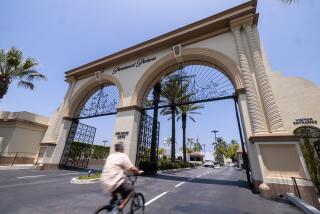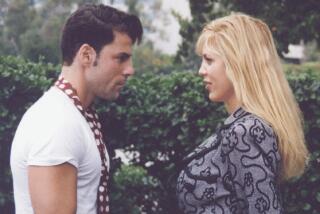Rescuing the classics: Computers do the nitty-gritty work
- Share via
There are horror stories surrounding the fate of the original film negatives of some of cinema’s best-loved classics. Orson Welles’ “Citizen Kane” and the Gene Kelly-Stanley Donen musical “Singin’ in the Rain” were both lost in a fire. Numerous other negatives shot on unstable nitrate stock -- all films before 1950 were shot on nitrate -- disintegrated, and others have just been lost over the years.
Add “Sunset Boulevard,” Billy Wilder’s landmark 1950 drama about Hollywood, and “Roman Holiday,” William Wyler’s delightful 1953 romantic comedy for which Audrey Hepburn won a best actress Oscar, to the list of films whose original negatives are long gone.
Phil Murphy, senior vice president of operations for Paramount Television, doesn’t know what happened to the negatives of those films. But when the studio began its preservation program in the mid-1980s, Murphy discovered that they were missing and that, with the passage of time, any trails that might have led to them are cold. “Remember, our industry didn’t recognize the true deep value of the library in the early days before television because, once something opened theatrically then there was no after market. It was a different industry.”
So when it came time to do the DVDs of “Sunset Boulevard” and “Roman Holiday,” which arrive in stores today, Paramount not only wanted the films to be restored for the digital editions but also to have new negatives created for both titles. (Since the inception of the studio’s protection program, original materials pertaining to films Paramount owns have been preserved in stable conditions to prevent further deterioration.)
“We would really like to be able to say not only did we do the absolute best we could do for a DVD release,” Murphy says. “We would also like to be able to say we have created the negative -- call it a lab original negative -- that puts it back on film virtually in the same condition it existed when the movies opened theatrically in the early ‘50s. For all the hoopla about electronic restoration and preservation that may be out there today, there still remains nothing that gives us the same confidence levels as a 35-millimeter motion picture film for preservation into the next 100 years.”
Though Paramount has no plans to re-release the films theatrically, the new film prints of “Sunset Boulevard” and “Roman Holiday” will be unveiled next week at the Museum of Modern Art in New York.
The best original materials Paramount had on both titles were third-generation duplicate negatives, which meant they were three generations away from the original camera negative and probably were made some 30 years ago. Paramount worked with four digital vendors on each movie, making tests for nearly a year, to see if the film could be restored digitally and then scanned back into film.
“I have to be honest with you: We came very close to abandoning the project,” Murphy says. “Sometimes it looked like video. The look just wasn’t correct, the whole texture of the image wasn’t right. Finally, at kind of the 11th hour, we seriously were contemplating pulling the plug.”
Then Murphy saw a test by Lowry Digital Images that impressed him.
“We focused on [Lowry]. It took another year to get to the point of actually delivering the finished project. We are still getting the last reels on film out the door.”
The result for both films is absolutely stunning on DVD: The black-and-white images are crisp, the detail is amazing, and the contrasts among blacks, grays and whites are beautifully rendered. The films look as if they were made yesterday.
John Lowry of Lowry Digital says the problem is that the more popular the title, the more work is needed to fix it.
“Successful movies tend to have too few protections made when they made the movie,” Lowry says. “They didn’t made enough duplicates, and they wore them out.”
“Roman Holiday” was a bigger challenge than “Sunset Boulevard.” “Frankly, a lot of shots are out of focus,” Lowry says. There are a lot of weird opticals. It wasn’t well lit.”
Lowry’s company used 270 computers to restore the movies. “We tell the computers what the parameters are in this particular movie,” he says. “It is all a series of mathematical calculations. If you think of it, we have more computer power working on these movies than existed in the world 30 years ago.”
The first step was getting rid of the films’ jitter and weave. “Every film camera introduces a bit of jitter and weave just by the nature of the sprocket holes,” Lowry says. “If it has been printed two or three [times], there is a little bit more movement introduced with each printing stage. Flicker is more a function of age.”
Then the grain -- the sand-like or granular texture noticeable in prints -- was reduced so Lowry’s computers could clean the image and get out the dirt, flaws and scratches from the prints.
For the last several months, Lowry has been working with Paramount to get the right tones of grays and blacks in each film. With old black-and-white films, Lowry says, the black tones tend to become crushed.
“You don’t see enough detail. The blacks are too black. We did some software to stretch that out to help us see the black a little bit better. We ended up using that software more on ‘Roman Holiday’ than ‘Sunset Boulevard,’ ” he says.
“We tried our best to maintain what we believe the original artistic intent was. We believe that is very, very important in any restoration work.”
While Lowry was working on the images, John Polito at Audio Mechanics restored the soundtrack, transferring an optical track negative to a 24-bit digital tape. He eliminated pops, clicks and crackles; certain sections were equalized to smooth anomalies created in editing.
Besides the restored film, the digital edition of “Sunset Boulevard” ($25) includes commentary by Ed Sikov, author of “On Sunset Boulevard: The Life and Times of Billy Wilder” (Hyperion, 1999); “The Making of Sunset Boulevard” documentary; a Hollywood location map; photo galleries; “The Music of Sunset Boulevard”; script pages of Wilder’s original morgue prologue, which was cut after previews; and 3 1/2 minutes of surviving footage from the original negative.
The DVD of the restored “Roman Holiday” ($25) also features “Remembering Roman Holiday” documentary, “Restoring Roman Holiday,” photo galleries and three trailers.
More to Read
Only good movies
Get the Indie Focus newsletter, Mark Olsen's weekly guide to the world of cinema.
You may occasionally receive promotional content from the Los Angeles Times.











